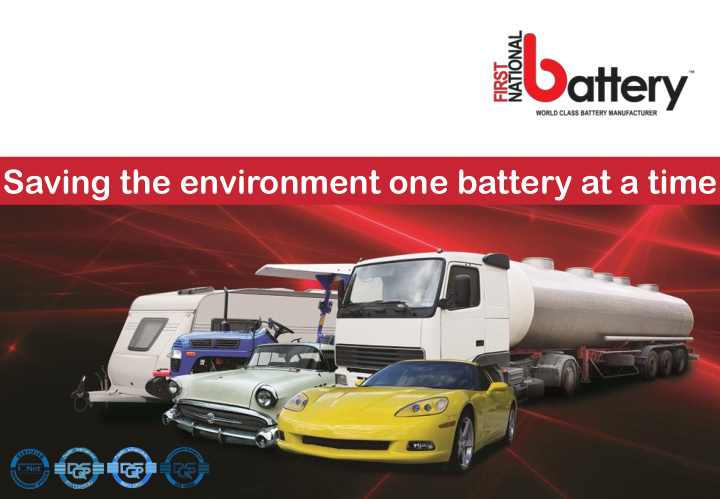



Saving the environment one battery at a time
Brief ef So South th Africa can n Co Company pany Histo tory ry 1931 1938 1947 1947 FIRST CHLORIDE RAYLITE OLDHAM NATIONAL ESTABLISHED ESTABLISHED ESTABLISHED BATTERY 1973 BEACON BATTERIES ACQUIRED 1976 1969 CHLORIDE RAYLITE 1990 1990 2010 • Purchase Third Nampak 1995 Building Wholly Owned by • Commissioning of AGM Metair Production Line 1995 1999 2001 2008 • Purchase Nampak Building Smelter Becomes Acquires Dedicated • Double Smelter capacity Darmag Plastic Industrial Plant Operational Plant opens
ving the e envir vironment onment one e Saving ba battery ttery at a time time In an age where it seems as though everything we do is harming the environment in some way or another, car batteries, golf cart batteries, UPS batteries, industrial fork-lift batteries, motorcycle batteries and commercial batteries, are posing a huge problem when they need to be discarded.
If incorrectly dealt with battery lead, plastic and acid, can negatively impact on the environment. Fortunately these components are well suited to recycling and First National Battery (FNB), a division of Metindustrial, a leading manufacturer and distributor of lead acid batteries, has taken the initiative to help save the environment by establishing a battery recycling facility in Benoni.
Reasons asons to o recycle le • Recycling is the reuse of materials that would ordinarily be considered waste. • Lessen the amount of waste that goes into landfills • Reduce the amount of toxic chemicals absorbed into the earth • Significantly reduce manufacturing costs and energy consumption.
How ow batt ttery ery recycli ling ng began an During the Second World War, when lead was considered a strategic metal, it was a legal requirement for the battery industry to introduce the “one -for- one” system. The South African Battery Manufacturers Association have, since 1942, continued with a system of collecting spent batteries that has proved to be efficient and relatively simple to operate.
By continuing this service the battery industry has achieved the following: • Protected the lead stock held in the country thus avoiding the unnecessary importation of lead • It has saved the country a vast amount of foreign exchange by enabling recycling to take the place of imported lead • It has ensured that the Polypropylene used in the manufacture of battery casings and lids is recycled. • The greatest advantage is that the battery industry has managed to stop the creationof a vast abundance of toxic waste in the form of sulphuric acid and lead from scrap batteries
FNB’s recycling process Scrap batteries – both automotive and industrial – are processed through a battery breaker, which after breaking separates lead, plastic and acid. This entire recycling process is carried out under the strictest environmental controls and accordingly has been ISO 14001:2004 certified.
Acid is neutralised and processed through an effluent plant and properly disposed of.
Plastic chips are sent to a processing plant where they are converted into pellets, which are then used at the FNB Fort Jackson plant to manufacture new battery containers, covers and other components
Battery plates, terminals and other extracted lead are refined and blended in the lead smelter located in Benoni to produce high quality lead alloys
This lead is then used in the manufacture of new batteries, at the two FNB battery manufacturing facilities in East London, thus completing the cycle.
Som ome e of of the he ma majo jor r benef nefit its of of ha having ing on ones s own smelt lter er in inclu lude de: • active contribution to positive ecological benefits • more control over quality • continuity of supply • relatively high recovery rate of lead from scrap • able to re-process dross and filtered materials • conservation of natural resources
PROCESS FLOW – SECONDARY SMELTING SCRAP BATTERIES SCRAP BREAKING ELECTROLYTE POLYPROPYLENE NEUTRALISED GRANULATE METALLICS CLEAN RE-USE REDUCTANT SMELTER AND FLUX DISCARD SLAG FINE DUST ALLOY BULLION MELTDOWN AND BLENDING DROSS (BASE METAL ADDITION FOR ALLOY SPEC) CAST INGOTS GP November 2015
Recommend
More recommend